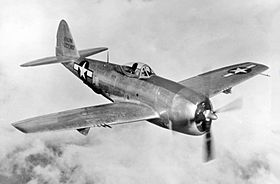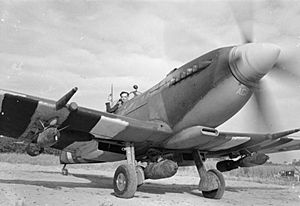Fighter-bomber facts for kids

A fighter-bomber is a fighter aircraft that has been modified, or used primarily, as a light bomber or attack aircraft. It differs from bomber and attack aircraft primarily in its origins, as a fighter that has been adapted into other roles, whereas bombers and attack aircraft are developed specifically for bombing and attack roles.
Although still used, the term fighter-bomber has less significance since the introduction of rockets and guided missiles into aerial warfare. Modern aircraft with similar duties are now typically called multirole combat aircraft or strike fighters.
Contents
Development

Prior to World War II, general limitations in available engine and aeronautical technology required that each proposed military aircraft have its design tailored to a specific prescribed role. Engine power grew dramatically during the early period of the war, roughly doubling between 1939 and 1943. The Bristol Blenheim, a typical light bomber of the opening stages of the war, was originally designed in 1934 as a fast civil transport to meet a challenge by Lord Rothermere, owner of the Daily Mail. It had two Bristol Mercury XV radial engines of 920 hp (690 kW) each, a crew of three, and its payload was just 1,200 lb (540 kg) of bombs. The Blenheim suffered disastrous losses over France in 1939 when it encountered Messerschmitt Bf 109s, and light bombers were quickly withdrawn.
In contrast, the Vought F4U Corsair fighter—which entered service in December 1942—had in common with its eventual U.S. Navy stablemate, the Grumman F6F Hellcat and the massive, seven-ton USAAF Republic P-47 Thunderbolt—a single Pratt & Whitney R-2800 Double Wasp radial engine of 2,000 hp (1,500 kW) in a much smaller, simpler and less expensive single-seat aircraft, and was the first aircraft design to ever fly with the Double Wasp engine in May 1940. With less airframe and crew to lift, the Corsair's ordnance load was either four High Velocity Aircraft Rockets or 2,000 lb (910 kg) of bombs; a later version could carry eight rockets or 4,000 lb (1,800 kg) of bombs. The massive, powerful 18-cylinder Double Wasp engine weighed almost a ton—half as much again as the V12 Rolls-Royce Merlin and twice as much as the 9-cylinder Bristol Mercury that powered some heavy fighters.
Increased engine power meant that many existing fighter designs could carry useful bomb loads, and adapt to the fighter-bomber role. Notable examples include the Focke-Wulf Fw 190, Hawker Typhoon and Republic P-47 Thunderbolt. Various bombing tactics and techniques could also be used: some designs were intended for high-level bombing, others for the low-level semi-horizontal bombing, or even for low-level steep dive bombing as exemplified by the Blackburn Skua and North American A-36 Apache.
Larger twin-engined aircraft were also used in the fighter-bomber role, especially where longer ranges were needed for naval strikes. Examples include the Lockheed P-38 Lightning, the Bristol Beaufighter (developed from a torpedo bomber), and de Havilland Mosquito (developed from an unarmed fast bomber). The Beaufighter MkV had a Boulton-Paul turret with four 0.303 in (7.7 mm) machine guns mounted aft of the cockpit but only two were built. Bristol's Blenheim was even pushed into service as a fighter during the Battle of Britain but it was not fast enough. Equipped with an early Airborne Interception (AI) radar set, however, it proved to be an effective night fighter.
Post-war
Fighter-bombers became increasingly important in the 1950s and 1960s, as new jet engines dramatically improved the power of even the smallest fighter designs. Many aircraft initially designed as fighters or interceptors found themselves in the fighter-bomber role at some point in their career. Notable among these is the Lockheed F-104 Starfighter, first designed as a high-performance day fighter and then adapted to the nuclear strike role for European use. Other U.S. examples include the North American F-100 Super Sabre and the McDonnell Douglas F-4 Phantom II, each of which was widely used during the Vietnam War.
Images for kids
-
The F-series models of the Focke-Wulf Fw 190 were specifically adapted for the fighter-bomber role.
-
A Vought F4U Corsair with USMC markings
See also
 In Spanish: Cazabombardero para niños
In Spanish: Cazabombardero para niños
- Dive bomber
- Light bomber
- Tactical bombing
- Attack aircraft
- Multirole combat aircraft
- Strike fighter






